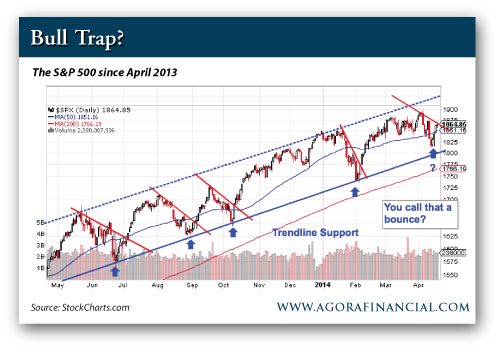The 2 Forces Driving the Current Stock Market Boom
Stocks are flat as a new week begins: The only movement to speak of is in the Russell 2000, down about a third of a percent.
The S&P 500 sits at 1,865, about 25 points below its all-time closing high on April 2.
“Last week was very one-sided,” says Jonas Elmerraji of our trading desk. “In just four trading sessions, the S&P 500 gained a whopping 2.71%.
“The big question on my mind right now is whether last week’s leg up was the latest trendline bounce. If so, it’s the first one that didn’t violate support on an intraday basis, and it’s the first one that didn’t break out of its short-term downtrend within 1% of our support line.
“In other words, it doesn’t look like a bounce yet — more like a bull trap.” Jonas’ STORM Signals readers continue to sit on the sidelines, as they have for a month now.
“Every bull market is made up of different ingredients,” says Paul Mampilly — our newly named investment director here at Agora Financial.
That doesn’t sound like any great revelation — until someone tries to sucker you in with a “surefire” market indicator.
Beware, Paul warns: “Marc Faber says that the 2014 stock market crash is going to be worse than the one in 1987. The U.K. Telegraph has put out a top 10 list of warnings signs of a new market crash in 2014.
“The gloomers are competing to find a way to show you the market is overvalued using newfangled methods with names like CAPE — which stands for ‘cyclically adjusted price-earnings,’ also known as the Shiller P/E.
“The optimists have struck back with one of their own,” says Paul — the rule of 20. “This method of valuing the market says you take the S&P 500’s P/E ratio and add inflation. If this magic number is below 20, you buy. If this number is above 20, you sell.
“Neither calculation means anything,” says Paul. “At least not anything useful, anyway.”
Before you throw up your hands in disgust and click out of today’s episode, hear Paul out: “Let’s start with CAPE. If you use that measure, you would not have bought stocks at the bottom in March 2009. And this measure has kept you out of stocks for the whole bull market that has followed. What good is a system that keeps you out when stocks are going to double? No good at all.
“What about the rule of 20? Unfortunately, as neat as that rule sounds, it’s pretty bogus too. Here’s why. At the end of 2008, more or less the beginning of the biggest bull market ever, the P/E plus inflation rate was well over 70. But stocks were still a buy. Well, then what good is a system that keeps you out of the greatest bull market in history? No good at all.”
Which brings us back to Paul’s maxim, drawn from 25 years of experience: Every bull market has different drivers.
“I believe the current stock market boom is driven by two things,” says Paul: “People buying stocks for dividends and companies buying their own stock.
“For me, that means the stock market keeps going up (not in a straight line) as long as these two things keep going.
“In 2013, stock buybacks totaled $478 billion. In 2013, the Nasdaq Buyback Achievers index — which invests in companies that have bought at least 5% of their stock in the last year — was up 40%, compared with 26% for the S&P 500.”
Regards,
Dave Gonigam
for The Daily Reckoning
P.S. Of course, no one knows whether 2014 will bring another crash, or whether the current boom will continue unabated. The only thing you can do is prepare for either one. That’s why we write the 5 Min. Forecast. Click here now to sign up, and discover specific ways you can protect your wealth no matter what happens.




Comments: